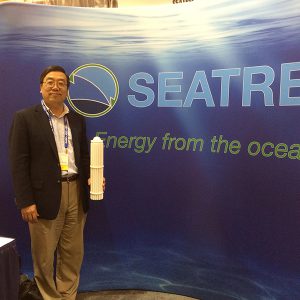The city of Jazz and Mardi Gras, New Orleans, was the site of the 2016 Ocean Sciences meeting. The multiple concurrent sessions, plenaries, town halls, exhibits, and thousands of posters can make your head spin. With the ocean science community converging in one location, many side meetings took place as well as many hugs as distant colleagues came together once again. Zdenka Willis, Gabrielle Canonico, and Hassan Moustahfid attended from the U.S. IOOS program office. Zdenka focused on the release of the Ocean Enterprise study, Gabrielle on the marine biodiversity observation network (MBON) and Hassan on the integration of biological observations.
Zdenka participated in a town hall sponsored by Laurie Jugan with the Maritime Industries Science and Technology (MIST) cluster. She joined Barb Kirkpatrick, GCOOS Executive Director, Steve Howden, University of Southern Mississippi and Ruth Perry, Shell Oil to present perspectives from GCOOS, academia and industry on the Blue Economy. U.S. IOOS and NOAA released the Ocean Enterprise Study the week before Ocean Sciences, and Zdenka's presentation focused on the results of that study. What do the Ocean Enterprise and the National Football League have in common? Find out in Zdenka’s briefing here. (Hint: it involves the number 7.)
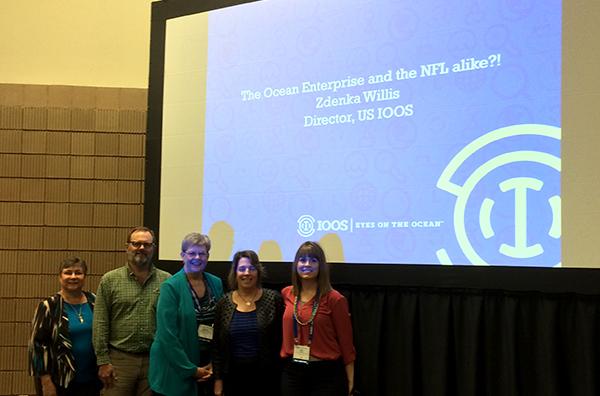
Laurie Jugan, Steve Howden, Barb Kirkpatrick, Zdenka Willis, and Ruth Perry at MIST Town Hall. Photo Credit: IOOS/NOAA
The Principal Investigators and team members from all three of the U.S. MBON projects met at the conference to share progress and updates. The large conference room was packed! Each of the projects was well represented, and there was strong participation from MBON partners, in particular Emmett Duffy, Director of Smithsonian's Tennenbaum Marine Observatories Network. Woody Turner (NASA) and Gabrielle Canonico (U.S. IOOS/NOAA) kicked off the meeting; discussion focused on data management approaches, genomics and eDNA method refinement, progress on seascapes (an effort to integrate remote sensing with in-situ data in a landscape ecology approach), and identification of Essential Biodiversity Variables/core variables for national and global MBON. A lot is happening with MBON, including the launch of their new website, where you can check in and follow along as the network grows and projects develop.
Great Oral and Poster sessions on "Integrating Biological and Physicochemical Observations into the Ocean Observing Framework to Inform Understanding of Ecosystem Function and Ecosystem-Based Decision Making I and II". Eight oral presentations and twelve posters were scheduled for this topic. Hassan Moustahfid (U.S. IOOS) gave the opening talk on "Bio" sensors integration with ocean observing systems. Scott Gallager (WHOI) followed with his presentation on Ocean Cubes as an affordable cabled observatory system. Ward Appeltans (IOC/iOBIS) presented the new extension of OBIS data model based on Event ID that capture environmental data. Heidi Sosick (WHOI) talked about FlowCytobot and ImagingFlowCytobot to monitor phytoplankton composition and Harmful Algal Blooms. Kim Holland (UH/HIMB) presented the results from his first study to use an animal-borne device (DO-PATs Tag) to autonomously measure and record in situ dissolved oxygen saturation from non-air-breathing marine animals (bluntnose sixgill shark). Mark Baumgartner (WHOI) talked about real-time passive acoustic system from a variety of autonomous platforms including gliders. Frederick Whoriskey (OTN) talked about Ocean Tracking Network to meet the blue ocean agenda. And finally Mike Weise presented the U.S. Animal Telemetry Network implementation plan. Biological data management was a very strong theme in the poster session. OBIS, OTN and MBON all had posters to address biological data management challenges and existing solutions.
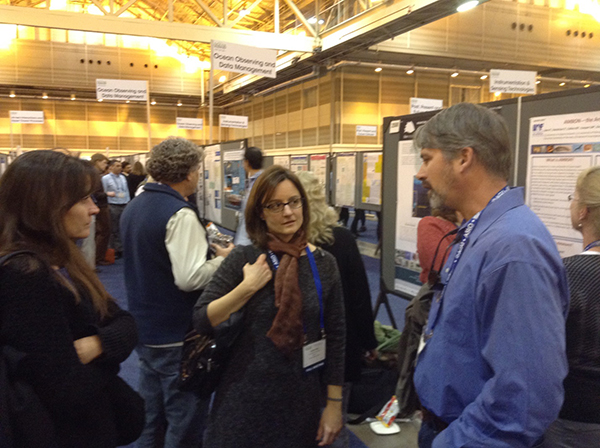
Margot Bohan (OER), Gabrielle Canonico, and Bob Miller (UCSB) during Poster Session. Photo Credit: IOOS/NOAA
We connected with companies that are strong participants of U.S. IOOS. CODAR Ocean Sensors, who provide 90% of the US IOOS HF Radars, got into the Mardi Gras mood by providing CODAR beads for all! Datawell wave buoys, used by the United States Army Corps Coastal Data Information Program and U.S. IOOS, were represented by Eric Stoker and Mark Bushnell. Mark is no stranger to U.S. IOOS because he is the manager for the very successful QARTOD program.
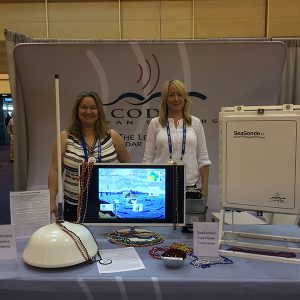
Laura Pederson and Maeve Daugharty, CODAR, show the latest SeaSonde products. Photo Credit: IOOS/NOAA
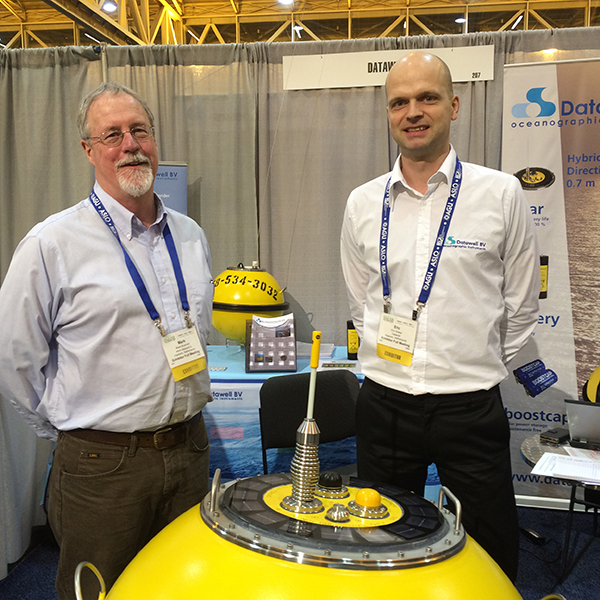
Mark Bushnell and Eric Stoker with Datawell buoy. Photo Credit: IOOS/NOAA
 Official websites use .gov
A .gov website belongs to an official government organization in the United States.
Official websites use .gov
A .gov website belongs to an official government organization in the United States.
 Secure .gov websites use HTTPS
A lock or https:// means you’ve safely connected to the .gov website. Share sensitive information only on official, secure websites.
Secure .gov websites use HTTPS
A lock or https:// means you’ve safely connected to the .gov website. Share sensitive information only on official, secure websites.


